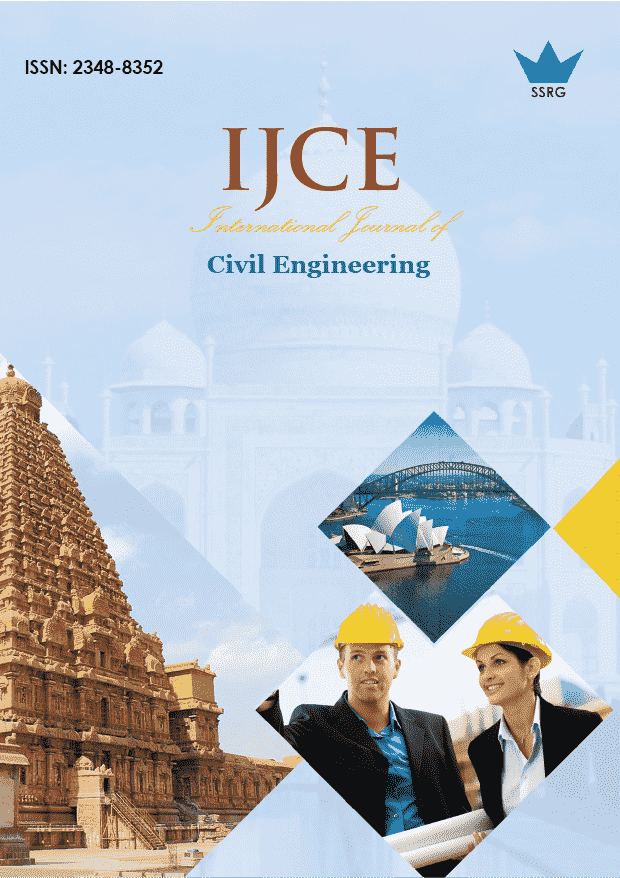Microclimate Variation and Thermal Comfort Analysis in Janeshwar Mishra Park, Lucknow: A Zonal Study of Hardscape, Softscape, Waterbody, and Shaded Areas

| International Journal of Civil Engineering |
| © 2025 by SSRG - IJCE Journal |
| Volume 12 Issue 10 |
| Year of Publication : 2025 |
| Authors : Upma Verma, Fulena Rajak, Sandeep Kumar |
How to Cite?
Upma Verma, Fulena Rajak, Sandeep Kumar, "Microclimate Variation and Thermal Comfort Analysis in Janeshwar Mishra Park, Lucknow: A Zonal Study of Hardscape, Softscape, Waterbody, and Shaded Areas," SSRG International Journal of Civil Engineering, vol. 12, no. 10, pp. 37-51, 2025. Crossref, https://doi.org/10.14445/23488352/IJCE-V12I10P103
Abstract:
Microclimate within the park influences the usability of different spaces within the park. As different spaces have their own thermal comfort, it is necessary to know how thermal comfort in areas like Hardscape, Softscape, Waterbody, and Shaded structure behaves with and without tree cover. This study is based on field data comprising air temperature, relative humidity, globe temperature, wind speed, global radiation, and surface temperature for Asia’s largest park in Lucknow, India. The simulated data presents PET and MRT with the help of the Rayman software, and the data of all the zones are compared based on the presence and absence of tree cover. The results suggest that the shaded structure has more thermal comfort than others, followed by the Softscape area, and there is a drastic difference in mean PET between with and without trees for the near water body and hardscape area.
Keywords:
Microclimate, Thermal Comfort, Urban Park, Landscape Component.
References:
[1] Pardeep Kumar, and Amit Sharma, “Study on Importance, Procedure, and Scope of Outdoor Thermal Comfort –A Review,” Sustainable Cities and Society, vol. 61, 2020.
[CrossRef] [Google Scholar] [Publisher Link]
[2] H. Akbari, M. Pomerantz, and H. Taha, “Cool Surfaces and Shade Trees to Reduce Energy use and Improve Air Quality in Urban Areas,” Solar Energy, vol. 70, no. 3, pp. 295-310, 2001.
[CrossRef] [Google Scholar] [Publisher Link]
[3] Dayi Lai et al., “Outdoor Space Quality: A Field Study in an Urban Residential Community in Central China,” Energy and Buildings, vol. 68, pp. 713-720, 2014.
[CrossRef] [Google Scholar] [Publisher Link]
[4] M.A. Said, and M. Touahmia, “Evaluation of Allocated Areas for Parks and their Attributes: Hail City,” Engineering Technology & Applied Science Research, vol. 10, no. 1, pp. 5117-5125, 2020.
[CrossRef] [Google Scholar] [Publisher Link]
[5] Marialena Nikolopoulou, and Koen Steemers, “Thermal Comfort and Psychological Adaptation as a Guide for Designing Urban Spaces,” Energy and Buildings, vol. 35, no. 1, pp. 95-101, 2003.
[CrossRef] [Google Scholar] [Publisher Link]
[6] ANSI/ASHRAE Standard 55: Thermal Environmental Conditions for Human Occupancy, ASHRAE, pp. 1-9, 2020.
[Google Scholar] [Publisher Link]
[7] Sarah Binte Ali, and Suprava Patnaik, “Thermal Comfort in Urban Open Spaces: Objective Assessment and Subjective Perception Study in Tropical City of Bhopal, India,” Urban Climate, vol. 24, pp. 954-967, 2018.
[CrossRef] [Google Scholar] [Publisher Link]
[8] Sin Yi Chan, and Chi Kwan Chau, “On the Study of the Effects of Microclimate and Park and Surrounding Building Configuration on Thermal Comfort in Urban Parks,” Sustainable Cities and Society, vol. 64, 2021.
[CrossRef] [Google Scholar] [Publisher Link]
[9] Chen Yu, and Wong Nyuk Hien, “Thermal Benefits of City Parks,” Energy and Buildings, vol. 38, no. 2, pp. 105-120, 2006.
[CrossRef] [Google Scholar] [Publisher Link]
[10] Nyuk Hien Wong et al., “Investigation of Thermal Benefits of Rooftop Garden in the Tropical Environment,” Building and Environment, vol. 38, no. 2, pp. 261-270, 2003.
[CrossRef] [Google Scholar] [Publisher Link]
[11] Majid Amani-Beni et al., “Impact of Urban Park’s Tree, Grass and Waterbody on Microclimate in Hot Summer Days: A Case Study of Olympic Park in Beijing, China,” Urban Forestry & Urban Greening, vol. 32, pp. 1-6, 2018.
[CrossRef] [Google Scholar] [Publisher Link]
[12] E.A. Hathway, and S. Sharples, “The Interaction of Rivers and Urban Form in Mitigating the Urban Heat Island Effect: A UK Case Study,” Building and Environment, vol. 58, pp. 14-22, 2012.
[CrossRef] [Google Scholar] [Publisher Link]
[13] Shubham Meena, and Bijay Kumar Das, “Microclimate Analysis of Ganga Riverfront in Patna: Spatial form Perspective,” Journal of Asian Architecture and Building Engineering, vol. 24, no. 5, pp. 4369-4388, 2025.
[CrossRef] [Google Scholar] [Publisher Link]
[14] Data Sheet, Census 2011 Provisional Rovisional Population Opulation Totals, Office of the Registrar General and Census Commissioner, New Delhi, India, pp. 1-58, 2011.
[Google Scholar] [Publisher Link]
[15] Hylke E. Beck et al., “Present and Future Köppen-Geiger Climate Classification Maps at 1-km Resolution,” Scientific Data, vol. 5, pp. 1-12, 2018.
[CrossRef] [Google Scholar] [Publisher Link]
[16] M.C. Peel, B.L. Finlayson, and T.A. McMahon, “Updated World Map of the Köppen-Geiger Climate Classification,” Hydrology and Earth System Sciences, vol. 11, no. 5, pp. 1633-1644, 2007.
[CrossRef] [Google Scholar] [Publisher Link]
[17] Rahul Verma et al., “Design and Optimization of Energy Consumption for a Low-Rise Building with Seasonal Variations Under Composite Climate of India,” Journal of Solar Energy Engineering, vol. 145, no. 1, pp. 1-25, 2023.
[CrossRef] [Google Scholar] [Publisher Link]
[18] Anugya Shukla, and Kamal Jain, “Analyzing the Impact of Changing Landscape Pattern and Dynamics on Land Surface Temperature in Lucknow City, India,” Urban Forestry & Urban Greening, vol. 58, 2021.
[CrossRef] [Google Scholar] [Publisher Link]
[19] Anand Nidhi et al., “Avian Diversity and Their Status in Janeshwar Mishra Park, Lucknow, Uttar Pradesh, India,” International Journal of Zoological Investigations, vol. 9, no. 2, pp. 224-235, 2023.
[CrossRef] [Publisher Link]
[20] Andreas Matzarakis, Frank Rutz, and Helmut Mayer, “Modelling Radiation Fluxes in Simple and Complex Environments—Application of the RayMan Model,” International Journal of Biometeorology, vol. 51, pp. 323-334, 2007.
[CrossRef] [Google Scholar] [Publisher Link]
[21] Andreas Matzarakis, and Frank Rutz, “Application of the Rayman Model in Urban Environments,” Freiburg: Meteorological Institute, Freiburg, pp. 1-5, 2010.
[Google Scholar] [Publisher Link]
[22] Andreas Matzarakis, Frank Rutz, and Helmut Mayer, “Modelling Radiation Fluxes in Simple and Complex Environments: Basics of the RayMan Model,” International Journal of Biometeorology, vol. 54, pp. 131-139, 2009.
[CrossRef] [Google Scholar] [Publisher Link]
[23] A. Matzarakis, and D. Fröhlich, “Influence of Urban Green on Human Thermal Bioclimate - Application of Thermal Indices and Micro-Scale Models,” ISHS Acta Horticulturae 1215: International Symposium on Greener Cities for More Efficient Ecosystem Services in a Climate Changing World, pp. 1-10, 2018.
[CrossRef] [Google Scholar] [Publisher Link]
[24] Andreas Matzarakis, Marcel Gangwisch, and Dominik Fröhlich, RayMan and SkyHelios Model, Urban Microclimate Modelling for Comfort and Energy Studies, Springer, pp. 339-361, 2021.
[CrossRef] [Google Scholar] [Publisher Link]
[25] Fanzheng Meng et al., “A Review of RayMan in Thermal Comfort Simulation: Development, Applications and Prospects,” Building and Environment, vol. 270, 2025.
[CrossRef] [Google Scholar] [Publisher Link]
[26] Rajashree Kotharkar, Parikshit Dongarsane, and Aveek Ghosh, “Quantification of Summertime Thermal Stress and Pet Range in a Tropical Indian City,” Urban Climate, vol. 53, 2024.
[CrossRef] [Google Scholar] [Publisher Link]

 10.14445/23488352/IJCE-V12I10P103
10.14445/23488352/IJCE-V12I10P103